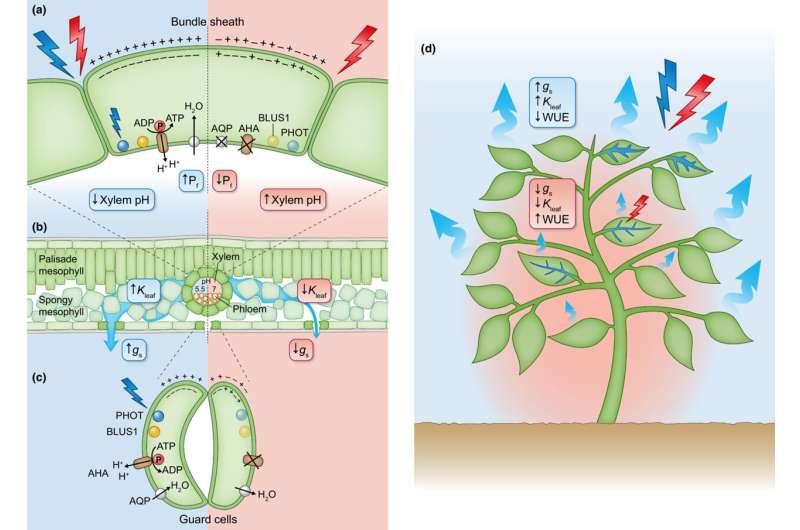This article has been reviewed according to Science X's editorial process and policies. Editors have highlighted the following attributes while ensuring the content's credibility:
fact-checked
peer-reviewed publication
trusted source
proofread
Illuminating plant water dynamics: The role of light in leaf hydraulic regulation

A recent study led by Prof. Menachem Moshelion from The Robert H. Smith Faculty of Agriculture, Food and Environment at The Hebrew University, along with Dr. Yael Grunwald and Dr. Adi Yaara from the same institute, has unveiled the intricate relationship between light conditions, particularly the Blue-Light (BL) to Red-Light (RL) ratio, and leaf hydraulic conductance (Kleaf) across various canopy areas has been revealed.
The plant canopy, essentially the upper layer of vegetation in a plant, plays a crucial role in light interception and photosynthesis, acting as the vital connection between plants and their surroundings. It is heavily influenced by factors such as light intensity and quality, profoundly impacting photosynthesis—a fundamental process in plant growth.
This investigation unveils how these light variations impact all aspects of plant hydraulic and gas conductance. This study focuses on how the balance of blue and red light in these bright areas helps control the water flow within plant leaves. It does this by affecting the water permeability of cells near the plant's vascular tissue (the plant's water transport system), which meets the high water demand.
On the other hand, in shaded areas, where there's less light, plants have lower water needs. These shaded leaves are more efficient in using water because they lose less water through transpiration, and they still support photosynthesis (a fundamental process) for plant growth due to the presence of red light.
This research explores the intricate mechanisms through which plants adapt to diverse environments, offering crucial insights for optimizing agricultural approaches, especially in regions where water management is critical, and deepening our comprehension of plant physiology.
Conversely, shaded inner-canopy areas experience lower light intensity, reduced water demands, and diminished leaf water transport due to lower intensity and BL induction. Intriguingly, despite these differences, shaded leaves exhibit higher water-use efficiency compared to their counterparts in the upper canopy. This heightened efficiency is attributed to decreased transpiration and cooling requirements in the shaded areas, while the presence of RL supports photosynthesis.
The study sheds light on the dynamic interplay between light conditions, water demands, and hydraulic conductance within different canopy regions, offering valuable insights into the adaptive strategies plants employ to thrive in varying environments.
The findings of this research not only contribute to our understanding of plant physiology but also have potential applications in optimizing agricultural practices, especially in areas where water management is crucial for crop productivity.
The study is published in the journal New Phytologist.
More information: Yael Grunwald et al, Illuminating plant water dynamics: the role of light in leaf hydraulic regulation, New Phytologist (2023). DOI: 10.1111/nph.19497
Journal information: New Phytologist
Provided by Hebrew University of Jerusalem





















